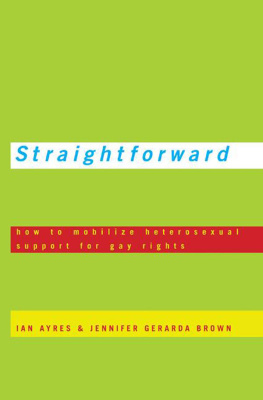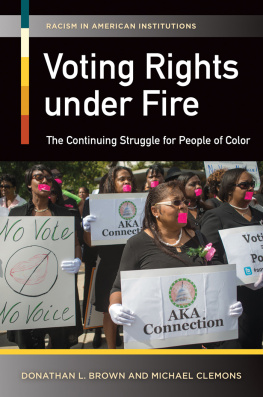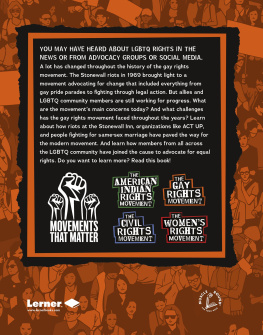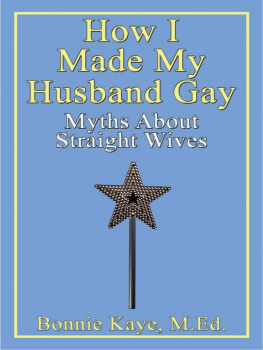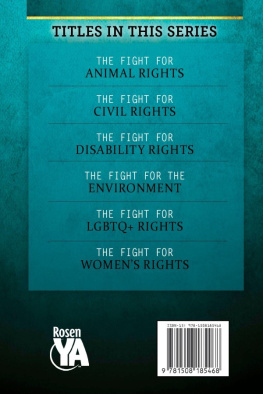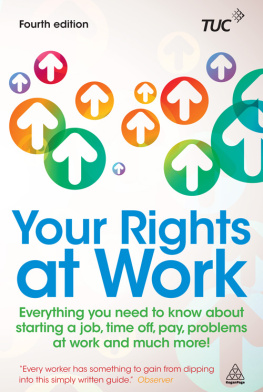Copyright 2005 by Princeton University Press
Requests for permission to reproduce material
from this work should be sent to Permissions,
Princeton University Press
Published by Princeton University Press,
41 William Street, Princeton, New Jersey 08540
In the United Kingdom: Princeton University Press,
3 Market Place, Woodstock, Oxfordshire OX20 1SY
All Rights Reserved
Library of Congress Cataloging-in-Publication Data
Ayres, Ian.
Straightforward : how to mobilize heterosexual support for
gay rights / Ian Ayres and
Jennifer Gerarda Brown.
p. cm.
Includes bibliographical references and index.
ISBN 0-691-12134-6 (alk. paper)
1. Gay rightsUnited States. 2. HeterosexualsUnited
StatesAttitudes. 3. HomophobiaUnited States
Prevention. I. Title: Straightforward. II. Brown,
Jennifer Gerarda, 1960 III. Title.
HQ76.8.U5A97 2005
323.32640973dc22 2004057504
British Library Cataloging-in-Publication Data is available
This book has been composed in Minion and Futura
Printed on acid-free paper.
pup.princeton.edu
Printed in the United States of America
1 3 5 7 9 10 8 6 4 2
PREFACE
Straightforward began in a conversation we had with Akhil Amar at our wedding reception in 1993. Akhil, in response to the Hawaii Supreme Courts decision that spring in Baehr v. Lewin, wondered about the economic impact of same-sex couples traveling to Hawaii to marry. Shortly thereafter, Jennifer embarked on a project to estimate the impact such marriages might have on Hawaiis economy. She followed with articles exploring the ramifications of a prohibition against judicial bias on the basis of sexual orientation that is on the books in well over half the states. Then she considered how states could pressure private organizations to end their policies of discrimination, even in the wake of the Supreme Courts decision in Dale v. Boy Scouts of America to allow the Boy Scouts to discriminate against gays. Her discussion responded to the Supreme Courts emphasis on expressive association. Jennifer saw that if a state required organizations to inform members about the organizations discriminatory policies, members might exercise their freedom not to associate.
For many years Jennifer had been interested in the special opportunities and challenges heterosexual allies face as they voice their support for gay rights. Stepping back to assess the series of articles she had written, she saw a set of strategies to harness or mobilize heterosexual support for gay rights. This book is a working out of this idea, as it applies to discrimination in employment, in private organizations and houses of worship, in marriage and families, and in the military.
Ian considers himself a bit of a Johnny-come-lately to the project, but the truth is that he, too, has long contemplated the dynamics of discrimination. In 1991 he published an article testing for race and gender discrimination in car sales. He moved on to study discrimination in a variety of markets and to support affirmative action as a remedy for that discrimination. These projects have sensitized him to the interplay between economic incentives and moral imperatives. They also fuel a
The issues raised in this book animate both our academic and our personal lives. We feel an abiding disquiet in choosing to marry when same-sex couples cannot, and we have continually struggled with how best to act in a country where the law formally and invidiously discriminates against people we love.
MANY, MANY people have helped us with this bookindeed, so many that if, in expressing our gratitude, we have inadvertently omitted someone, well be embarrassed but not surprised. We are particularly thankful to our family and friends, who were driven to distraction by our hectoring questions (Would you at least cross the street to marry in a nondiscriminatory jurisdiction?). Many people have helped us through conversations, by reading drafts, or by commenting on papers presenting the books ideas. Audrey and Ted Brown, Tara Ayres, Mary Coffield, Bo Roth, Jack Hitt, Diane Mazur, Akhil Amar, Kenji Yoshino, Bill Eskridge, Richard Epstein, Janet Halley, Elizabeth Emens, Andrew Koppelman, Robert Morris, Bruce Ackerman, Linda Meyer, Michael Ray, Evan Wolfson, Carlos Ball, William Bratton, Jon Macey, Mary Anne Case, Clark Freshman, Robert Wintemute and David Cruzthese would begin the list, but we could go on. Numerous faculty workshops where we presented chapters or related ideas helped tremendously: participants at Australian National University, UCLA, USC, Colorado, Georgetown, Harvard, Quinnipiac, Toronto, and the University of Virginia were engaged and generous readers. We thank Tim Sullivan, our editor at Princeton University Press, for making this book possible, and Richard Isomaki, whose able editing improved our style and substance. We are grateful to our colleagues at Yale and Quinnipiac (especially our assistants Marge Camera and Sue Passander), and to our deans, Anthony Kronman and Brad Saxton (and before Brad, Neil Cogan and David King), for their continued support throughout this multiple-year project. We have also benefited from the research assistance of Jeanine DeBacker, Todd Cleary, Jessica Ballou, Eric McGrew, Gowri Ramachandran, Richard Gora, Allison Kaye, Steven Wu, Nassir Zakariya, Praveen Krishna, Bijal Shah, Paul Breloff, and Tom Sylvester.
Finally, we thank our gay, lesbian, bisexual, and transgendered friends and family members for sharing their lives and their stories with us. We hope that the book is better for it. We know that we are.
STRAIGHTFORWARD
Heterosexual Allies and the Gay Rights Movement
A first-year law student named Nancy went to her Contracts class with Professor Jay expecting nothing out of the ordinary. But somewhere between sessions on promise and breach, between expectation and reliance, she one day noticed something quite different about Professor Jay. Jay, who combined left-leaning politics and scholarship with a distinctly conservative fashion sense, usually sported short hair, penny loafers, and oxford cloth shirts. But today, Nancy noticed, Professor Jay was also wearing bright green nail polish.
Unable to contain her curiosity, Nancy asked her professor about his new fashion statement. Jay explained that the day before, his young son Ted had come home in tears. On the playground that day, a group of children had encircled him with taunts about his long messy hair. Noticing Teds nail polish, they cruelly chided him for being abnormal. Later, a teacher found Ted hiding under a piece of play equipment, crying because one of his harassers had finally slapped him.

